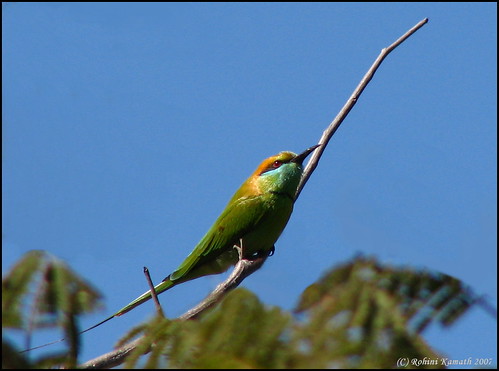My Bee eater wishes you all a happy new year.
Taken at Dev Narayan durga, full post pending.
Monday, December 31, 2007
Happy New Year
Wednesday, December 26, 2007
Keoladeo, Bharatpur
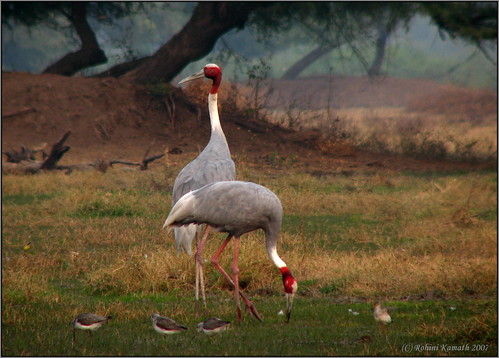
Sarus Cranes - the symbol of keoladeo
Keoladeo Ghana Bird Sanctuary is a 28.73 sq km lake and wetland; artificially created by the Maharaja of Bharatpur in the 19th century to shoot wild fowl. Now, no longer wet following 3 long years of drought, it still retains some birds.

Sambar Deer
We were warned ahead of our journey that the park was dry and desolate, but we still wanted to see it ourselves. Our trip was all of one day. We intended to take two trips into the park, but finally could make just one.
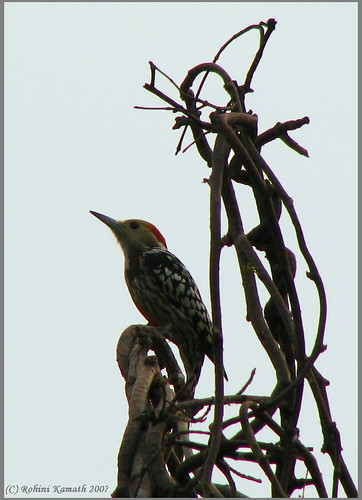
Mahratta WoodPecker
The park is open 6:30 am - 5:00 pm in winter. We arrived in Bharatpur around 11:30 am and after a wonderful rajasthani lunch, set off from the hotel at around 1:30pm
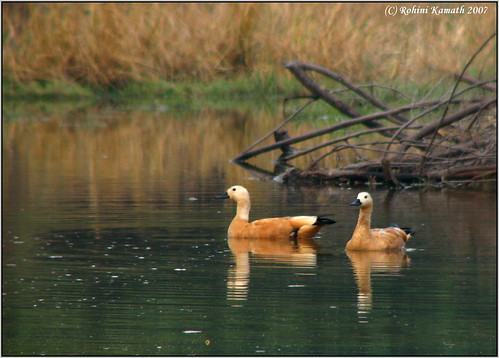
Brahminy Duck Pair
No motorized vehicles are allowed inside the park, the safaris are taken by cycle rickshaw. The rickshaw driver doubles up as a guide. Each cycle rickshaw seats 2 and the drivers are to be paid by the hour (Rs 50 / hr). Ticket for entry to the park is Rs.25 per head, the guide will purchase the same for you. The guides speak broken English and are fluent in Hindi. Cycles are available for hire as well. One can also go into the park by ones self on foot.
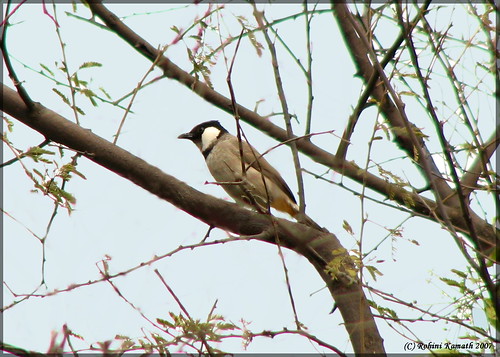
White Cheeked Bulbul
We were told that since the bird population of Bharatpur has come down considerably in the last 3 yrs, the Forest Dept is now allowing small excursions to see the pythons of Bharatpur. For this, the guides take you to a sight point where forest officials will lead you down a confusing pathway through the forest to where the pythons can be found. We were lucky to see one basking outside and a glimpse of the 2nd emerging from its hole.
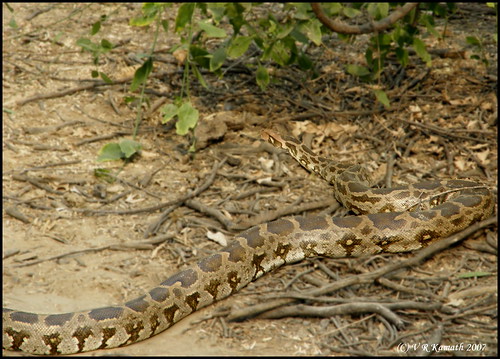
Python
After about 30 minutes of slow riding through the park, the bird population becomes slowly visible. Magpie Robins are extremely friendly to photographers and one pair actually came down to eye level about 4 feet from me to give me a better photo.
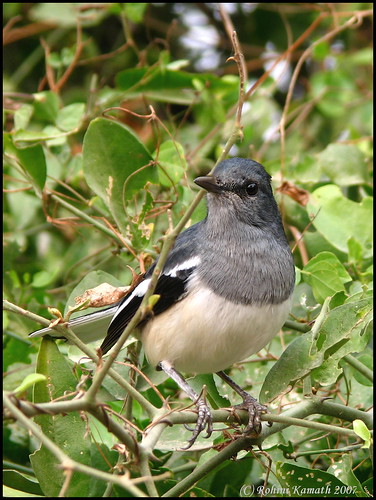
Magpie Robin (F)
Brahminy starlings are visible easily and are also very friendly, sitting patiently on dead trees.
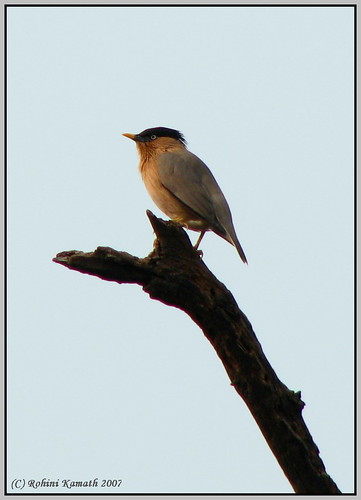
Brahminy Starling
The guides stop near a gate and the tourists are told to explore on foot along a walking track. Here some water birds can be seen, since water is now pumped by the forest dept to make up for the lack of rains. When the water level is high enough, boating is allowed there.
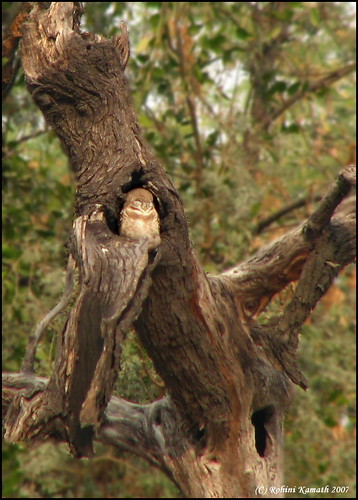
Spotted Owlet
We saw a lone black stork, who simply refused to turn around for photographs, as well as a pair of brahminy ducks. At certain points, we are allowed to get off the cycle and walk into the forest for a small distance, to take photos.
At the end of the road, there is a forest guest house and a small canteen and basic
toilets.
What I liked:
Our guide Bhajan Singh, an elderly man was excellent and extremely enthusiastic. We would recommend him. The cycle rickshaws are the best way to see the park, since without the keen eyes of the guide, one would miss out on many birds.
What I disliked:
A large number of students and locals were in the park, making a nuisance of themselves. It is extremely sad that the authorities could do little to curb this menace. They littered and sang songs, some climbed trees and shouted at the top of their voices. A group of youngsters sat around smoking.
There are practically no boards on the highway indicating the presence of the park, instead are huge photos of various politicians. One may need to stop and ask for directions.
Getting there:
The park is located 176 kms from Delhi; we reached Bharatpur from Mathura in around 1.5 hrs via a wonderful, very scenic road. Surprisingly, a large number of birds can be spotted along this road.
Park is around 20 minutes away from the Bharatpur railway station.
Bird Sightings (along the highway)
Painted Storks
Rose Ringed Parakeets
Drongos
Great Egret
Indian Rollers
Shikra
Black Winged Kite
Grey Shrike
Accomodation:
We stayed at Birders’s Inn, just 200 meters away from the bird reserve. The accomodation options at Bharatpur are rather limited. We decided against the Laxmi Vilas Palace since it was expensive to stay there for just one night.
The rooms were wonderfully furnished and very spacious. Service was pleasant, but required constant reminders. Our compliments to their chef, food was exceptional!
We were happy except for the non availability of hot water in the mornings or for that matter for any other time of day.
Birder's Inn houses a small souvenir shop in its restaurant.
Nitty Gritties
Car hire (Mathura -> Bharatpur + Mathura-Agra round trip) - Rs.2200
Safari charges + tip ( 2 rickshaws for 4 hours) - Rs. 500
Ticket to enter park - Rs. 75
Birder's Inn (24 hrs, all meals included) - Rs. 4045
Bird Sightings
Rose Ringed Parakeets
Magpie Robin ( M & F)
Rufus Tree Pie (Several)
Brahminy Starling (Several)
Pied Myna (flocks)
Red Start
Sarus Cranes (One Pair)
Brahminy Ducks (One Pair)
Painted Storks ( in flight )
Black Necked Stork (one)
Lesser Flame back woodpecker (one)
Mahratta Woodpecker (2)
Indian Roller
Lesser Coucal
Drongo (2)
Jungle Babbler (several)
Black Winged Kite (1)
Collared Scops Owl (4)
Spotted owlet (1)
White Breasted Kingfisher (2)
White Cheeked Bulbul (Yellow vented) – (1)
White Breasted Water hen
Indian Moor hen
Red vented Bulbul (several)
Ashy Prinia
Wire Tailed Swallow
Large Pied Wagtails
Yellow footed Green Pigeon
Little Brown Doves (several)
Purple Sun bird (eclipse male)
Weaver Bird nests ( didn’t see the birds)
Honey Buzzard
Red wattled Lapwing
Mammals
Neelgai (several)
Sambar Deer
Spotted Deer
Jackals (several)
Reptiles and Amphibians
Pythons (2)
Tortoise like creature, seen in the water
Note: More photos can be seen at Flickr
PS: Thanks to my Dad for lending his python to me for this blog
Friday, December 21, 2007
The Wonder of the Taj
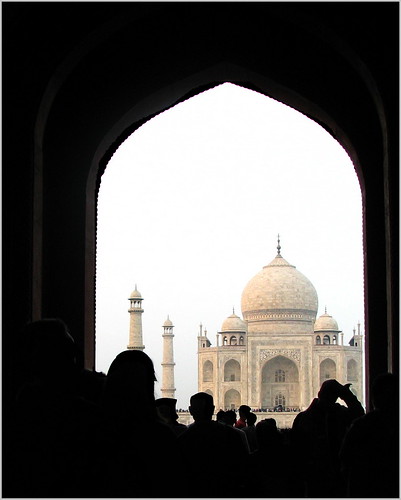
Having come as far as Delhi and Mathura, it would be unpardonable to not see the Taj. This prompted us to squeeze the monument into our packed itinerary.
I must state here, that I was not very keen on going along, though many had said that I would be wowed if not awed by the sight of the Marble Wonder.
I was awed indeed, not so much by the marble; more so by the traffic and the sheer number of people willing to stand in serpentine queues to see the most photographed spot in Agra.
Getting there
We reached Agra from Mathura by road, it took a little more than an hour on the wonderful highway that connects the two cities. Once we reached Agra, the traffic was horrendous; nearly 40 minutes were spent negotiating the roads till we came to our destination.
There was no parking available at the gate, I wonder why? Our driver parked in the street next to it, just a few meters away from the gate. The gate was poorly maintained, I could find no boards, no security and lots of garbage. A large number of touts set upon us, promising us anything for the right price.
From the entrance, the distance to the entrance gate is less than 1 km. The cycle rickshaw people will try their best to convince you that it is far far away. They take Rs 10 to cover the downhill distance.
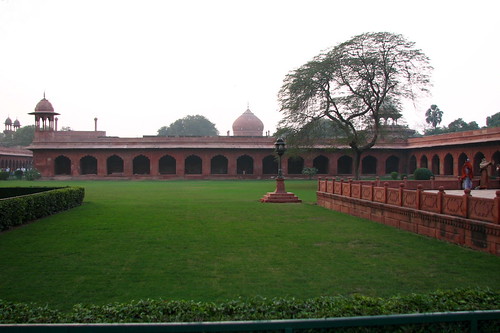
Taj Gardens
The gardens around the Taj are beautiful; however sadly, no one seems to want to see them. The rickshaw puller tried his best to con us, by suggesting that the Taj was closed, a VIP was visiting, and we’d never get to see it. Why not see a govt museum near by? He’d take us there for a discount prize of Rs. 50.
The Taj has four gates, N S E and W. The main gate can be identified by good roads, police presence and a queue longer than most trains. I could see no boards anywhere, explaining why people were in queues. Most tourists were generally milling about wondering what to do.

The touts then came up to us, wanting to sell us VIP tickets to see the Taj through “secret” gates, unknown entrances etc. The prices of these tickets dropped surprisingly in inverse proportion to the interest shown - coming down from Rs 500 per head, to Rs 100 for 3.
The actual price of Taj tickets is Rs.20 per head. We followed a line of Japanese tourists through many narrow pathways and gullies, constantly hounded by touts of various description. I’m not certain which gate we entered through, since there were no boards. Eventually we were in a serpentine queue in a narrow, dirty little lane. I was beginning to wonder if the Taj was worth this trouble.
There was a sudden shout of a separate Ladies queue, so the ladies formed a separate queue. This now meant that the males they were with were left behind, so the men then came in and joined the queue parallel to their wives/sisters/friends and quarreled with other members.
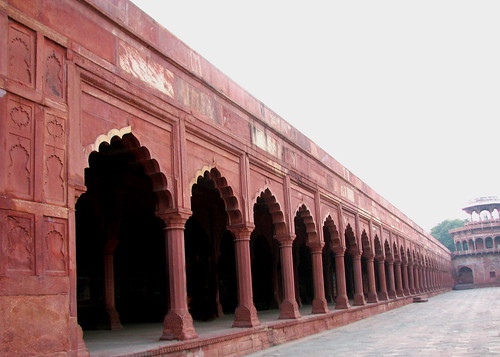
Way to the Loo - rather Grand looking isnt it?
Soon, some touts came up to certain people in the queue and handed over some little pieces of paper, looking like bus tickets. On enquiry, we were told by various people that this was the queue to see the Taj. To buy tickets, one had to stand at another gate. Taking multiple opinions, some seemed unaware of this, and said that the tickets would be bought at the end of the queue.
Finally a Japanese lady left the queue and went ahead, returning shortly with tickets for her group. I prompted mom to ask one of the shop keepers standing near her, (the narrow lanes are lined with shops on both sides). Finally the mystery was solved, my Mom left the queue, went ahead and bought tickets at the gate at a tiny shabby box (which has NO queue). She paid Rs 60 for 3 tickets. Each ticket comes in two pieces, a white piece and a blue piece - both are equally important. I then followed the queue back to where my Dad was in the Gents queue and gave him his ticket and explained the mystery to some astonished people on the way.
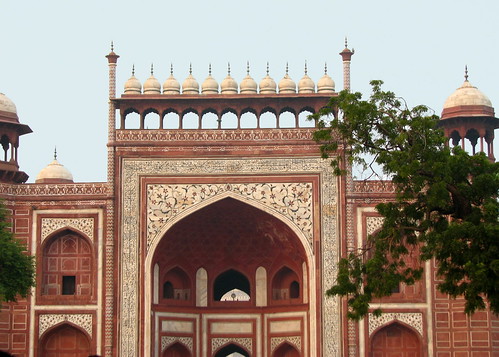
After nearly 30 minutes of waiting, the queue had finally reached the gate, now, people with only one ticket piece were shouted at by impatient security. The reason for the separate gender queues also became apparent; the people were to be frisked like at airport security. Bags were searched; any eatables found were snatched and promptly thrown away.

Cameras are allowed, cell phones were allowed when we went in, but several boards after the Taj gate said they were not. (We didn’t take any chances; we left ours at the hotel.)Video cameras are not allowed beyond the gate. (I wonder why?)
After a lot of pushing and shoving to get through the gate, we got out into an open space and could see the Taj Gates. Through these gates, the tide of humanity swept in on a resolute mission to photograph themselves in front of the marble wonder.
We did not go into the structure, being content to see it from afar. It was big, off-white and symmetric; it loomed large amidst the smog and swarms of ooh-ing and ah-ing tourists. I took a photo, and we turned around and left. The Taj closes at 5:30pm.
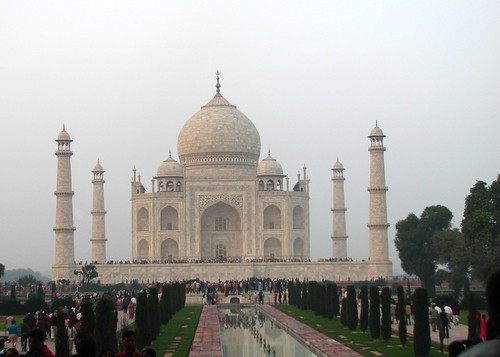
The Taj
As we walked back, the touts hounded us again, to buy little marble replicas of the Taj, key chains, statues; a piece of the original … the list was endless. All were con-men including those who insisted they were artisans.
I was disgusted by the whole experience; I pity the foreign tourists who come to see this hunk of discolored marble. The greatest wonder about the Taj, is the sheer number of people willing to suffer inconvenience just to have a glimpse of it.
On the way back to Mathura from Agra, we faced the mother of all highway jams and reached 2 hours later than schedule, missing the Aarti at Vishram ghat.
Tuesday, December 18, 2007
Vrindavan - The Land of Krishna
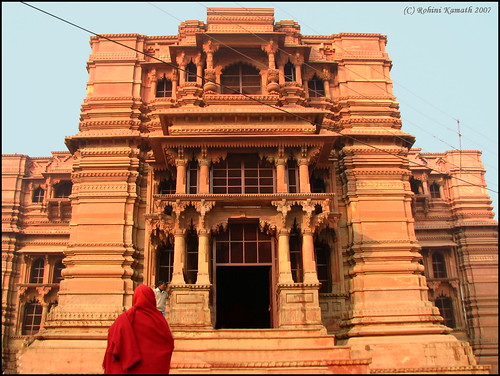
Meera Temple
This years vacation was primarily to Bharatpur and Ranthambore. I will cover them in separate posts. We started off from Bangalore, reaching Delhi by Air in 2.5 hrs(Kingfisher). This is the best way to travel up north, since the trains take for ever. The flights to Delhi are numerous and are far cheaper than traveling to lesser cities.
Delhi to Mathura can be reached conveniently in 3 hrs by passenger Train 4212 (Intercity Express) We opted to stay in Mathura instead of Delhi since Delhi is prohibitively expensive and some of the hotels we considered looked of dubious reputation.
Accommodation in Mathura
We stayed at Brijwasi Royal, just 1 Km from the railway station. The hotel is rated 3 star, and the accommodations are excellent, as is the food. Our room was comfortable, and had a wonderful view of a lake just adjacent to the hotel’s garden.
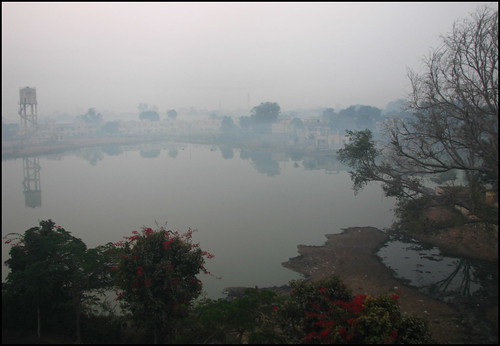
Around 30 minutes of rash driving in an auto will take one to Vrindavan. It is a small quiet town with extremely narrow walk ways (observe, I don’t call them roads)
Places to See
We made a deal with an auto driver to take us from our hotel to Vrindavan and back, it cost us Rs 450. Once you reach Vrindavan, there are several temples, situated close together, all within walking distance. A guide will walk you through them, telling you entertaining stories from the Krsna Leela and Mahabharat. We paid him Rs.200, and he was delighted.
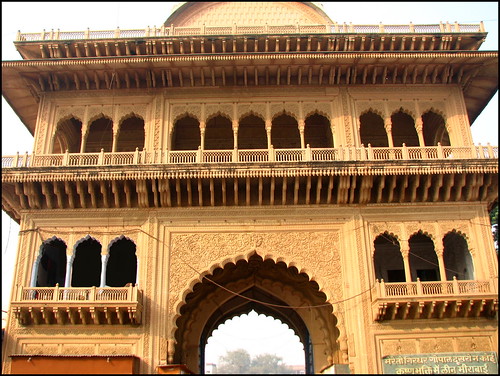
Ranganath Swami Gate
We visited 4 temples in Vrindavan, starting with the Meera Bai Temple. It has wonderful architecture and lots of bats. Some of the statues were defaced around the time of Aurangazeb. The main idol is no longer in the temple, as it was whisked away to Rajasthan, before it could be damaged.

Pillars of the Ranganath Swami Temple
Our second temple was the massive Ranganatha Swamy temple, built in the south Indian style with a huge campus around it, housing its 108 south Indian priests. Spotlessly clean and maintained exactly as it is, it is extremely impressive. Sadly, large portions of it cannot be photographed. We were lucky to see the idol of Vishnu and Lakshmi taken out on a procession on a huge chariot.
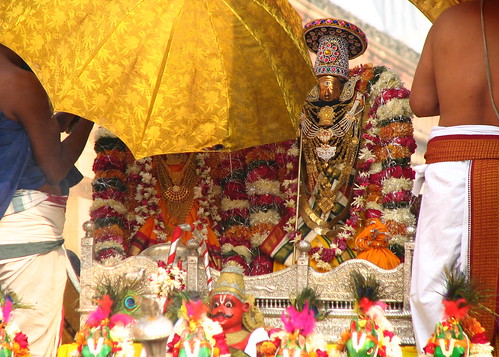
Golden Idols
From here we walked along extremely narrow lanes in what seemed to be a maze of pathways till we came to a tiny little ancient temple. This is the Vrindavan Bihari temple, one of the oldest temples in the town. Extremely small and very simple, the pathways and walls are covered in marble plaques, bearing the name of donors.
The idol is veiled thinly and shown to you in a flash by a jovial and friendly priest. He encourages the devotees to clap and laugh. This is a common feature in most temples here. I rather liked it. With charm and tact, the priest convinced us to add a marble plaque in our name to the temple, which we did.
We walked through the ghats where the clothes of the gopis were stolen and hung up on a tree by a playful Krsna. We went on to the madhuvan, which is now preserved rather like an orchard, with a few stunted trees; a path through them, leads to several tiny little temples.
Our last temple was the Banke Bihari, it had to be reached by auto. An extremely crowded road lay between us and the temple, for it was now nearing 11:30am. We made it to the temple, only to encounter more crowds inside. It rather looked like the floor of a busy stock exchange. Jostling for space to see the idol was a bit beyond us, so we headed out. The shops just outside the temple are a great place to buy souvenirs.
Sweet shops line the walkways and the adventurous can stop for a rabri or peda.
Finally we went to see Iskcon, Vrindavan. It is a beautiful white marble temple; sadly photography is prohibited, though you can carry your cameras inside (as long as you agree not to take any photos). The temple lacks the energy and enthusiasm that can be found in Iskcon Bangalore, so I was sorely disappointed. The shops just outside Iskcon are also a great place to shop for souvenirs. We had lunch at Iskcon’s Govinda restaurant, which serves excellent vegetarian food (with no onion and garlic).
The best time to see these temples is early morning (around 7), as the crowds build up as the day progresses.
What I liked
The TC at Mathura railway station was extremely helpful. The railway station had ramps and luggage could be easily pulled about.
There is no honking in vrindavan, people say “Radhe Radhe” to get others to move along.
The people are friendly and helpful, the temples are extremely clean. Our guide in Vrindavan, Vishnu Sharma; was wonderful, we would certainly recommend him.
Food was excellent, particularly the yogurt and the lassi.
The hotel accepts credit cards.
What I disliked
The service at the hotel was slow, several reminders needed to be given, particularly to Housekeeping. The front desk was unenthusiastic and unaware of the places to see around Mathura. Breakfast was later than scheduled, since most of the staff were clearly not awake at 7:00am.
The officials at the New Delhi railway station were rude and un-informed. The premises were filthy and I could not find a single book seller on the station. We were unable to locate any ramps.
Tips
In Vrindavan
Carry lots of loose change, this is needed to pay the shoe keepers outside the temples.
Wear floaters with thick dark colored socks, as the ground is extremely cold.
Do not wear spectacles / sunglasses, the monkeys in Vrindavan are notorious for snatching spectacles.
Mornings are extremely chilly, carry warm clothing. Carry a small bag/back pack to hold water/Prasad/souvenirs.
ATMs are available
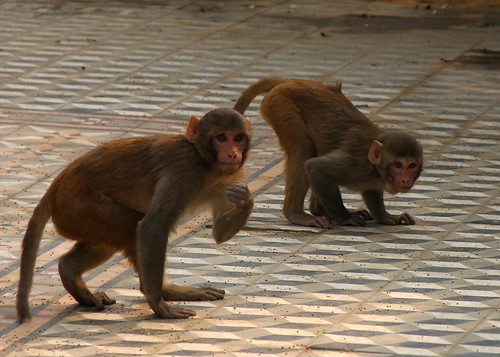
Naughty Monkeys of Vrindavan
In Delhi
When taking the prepaid taxi from the airport, take the govt taxis, the queue is the longest for these. (My manager Vivek, gave me this invaluable piece of advice)
If traveling in a group, send a person ahead to stand in the taxi queue, while the rest collect the baggage.
Do make allowances (2hrs at least) for train / flight delays in cold weather, due to fog/incompetence etc.
Nitty Gritties
Flight - Delhi from B’lore ( Kingfisher )
Train to Mathura from Delhi ( AC Chair Car )
Prepaid Taxi NewDelhi Airport to ND Railway station – Rs. 195, Time 40 min (dependent on traffic)
Stay at Brijwasi Royal ( Breakfast complimentary ) – Rs 5650 ( 2 nights, deluxe room)
Auto to Brijwasi Royal from Mathura railway station – 1 Km – 10 min – Rs 20 (locals pay 10)
Bird Sightings (at Hotel)
Pied Myna (Pair)
Pariah Kites
Rose Ringed Parakeets ( are like crows up north, can be seen everywhere )
Black Winged Stilts (several)
Magpie Robin (Male)
Rufus Tree Pie
Wednesday, December 5, 2007
Karanji Lake
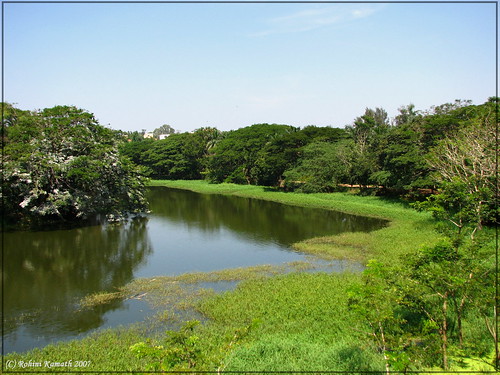
After Ranganathittu, we went on to Karanji Lake. Asking for directions (our driver was so drunk, he couldn’t figure out where it was) proved to be really hard (despite the fact that my Dad is fluent Kannada.)
Eventually it became clear that we should enquire about ‘Karanji Kere’, and not Lake. Once we had figured this out, it was easy to find.
Karanji Lake is not a natural lake, but a reservoir created by a king of mysore around a 100 years ago. (this is according to a board in the park, we don’t know when the board was put up)

Black Ibis
Tickets are sold for entry with an extra fee charged for still and video cameras; they don’t seem to be very strict about this. Cars which are parked in their not so ample parking area must also have tickets purchased. But, our driver was too drunk to be bothered and the guard was too sleepy to be concerned.
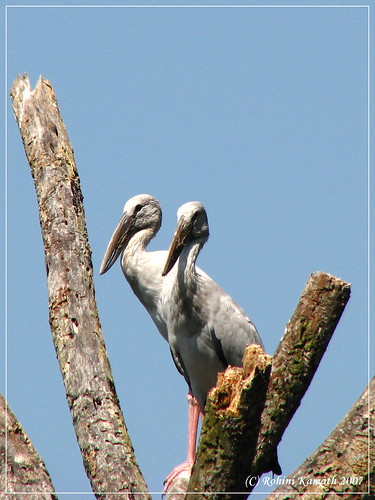
Open Billed Stork Twins
We were unable to cover the whole of the park; we walked along the pathways, and towards the enormous lake. On the tree stumps, submerged in the water, several water birds posed for photographs.
Sightings:
Black Ibis (Lone)
Asian Open Billed Stork (Several)
Darter – Snake Bird (Lone)
Cormorant
Large Cormorant
Purple Heron
Little Egret
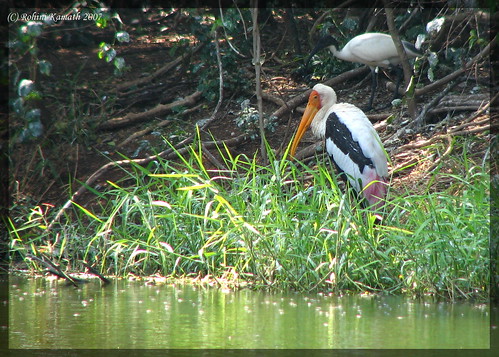
Painted Stork
Moving on, we walked up to the Aviary, which was a sad netted enclosure where Peacocks, ducks, rare pheasants and pigeons were jailed. They allow people to walk into it and photograph the birds with in. This is a bad practice since most people thought this was a great opportunity to chase the birds about. A harassed looking employee tried hard to keep them in check, and eventually gave up.
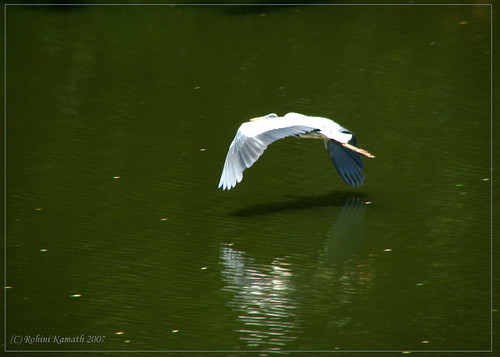
Grey Heron in Flight
We walked till the watch tower (its 3 storey high) which offers lovely views of the lake and trees which serve as heronries. We saw large numbers of sun birds in the bushes at the foot of the watch tower.
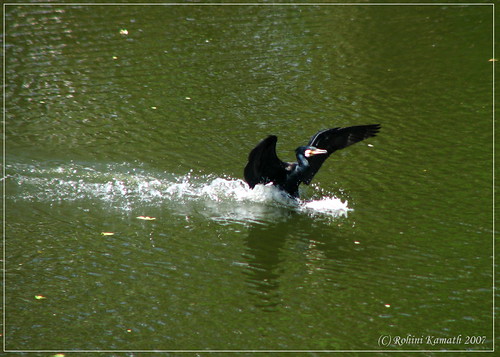
Large Cormorant Landing
Sightings
Spot Billed Pelicans (3)
Grey Heron (lone)
Large Cormorant
Large Egret (lone)
Brahminy Kites (two)
Painted Stork (2)
Black headed Ibis (2)
Little Grebe (lone)
Spot Billed Ducks (3)

Spot Billed Duck - Male (red markings)
Another 2 km in the same direction would have taken us to the butterfly park. But we were tired from all the walking. Keshav was tired of carrying his bazooka about, and mom who had thoughtfully packed a few kilos of edibles (which she lugged around along with our heavy binoculars) was tired too. I was totally exhausted, though I carried nothing more than my S3.
We left the butterfly park for another day.
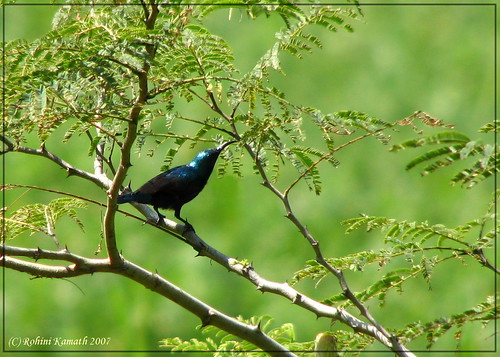
Purple Sun Bird - Male
Yes, people. I’m kind of free, hence the wholesale posting of long pending blogs. [:D] We are off on our vacation from 7th, will be back in B'lore on 14th.
Birding at Ranganathittu
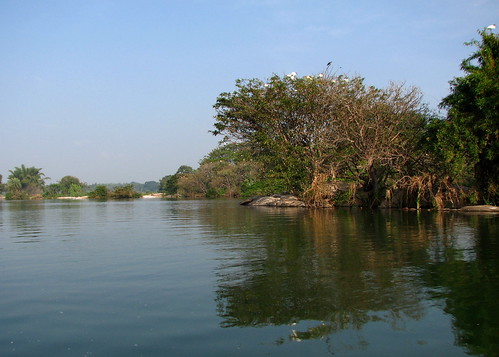
This was visit number three to Ranganthitttu and possibly was the most successful in terms of sightings so far. We reached the sanctuary, later than expected, at 7:45 (courtesy a drunk and sleepy driver from Pleasant Travels).
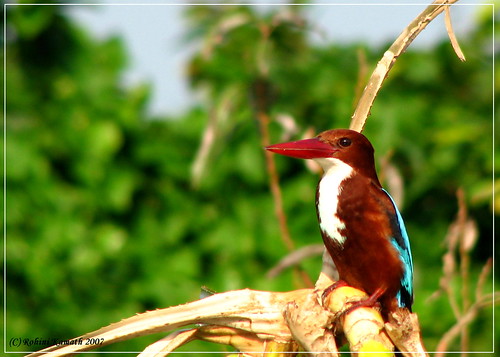
White Breasted Kingfisher
Our first bird sighting was of the Tickel’s Blue Flycatcher. For some odd reason, the photos I take of it are always shaky. Next we saw the Paradise flycatcher - Adult male with the white tail streamers, Keshav managed to get one shaky photo of the fickle little thing. These were sighted near the bamboo thicket on the way to the rest rooms.

We took a boat ride (we paid Rs. 250 to our boat man and guide) on the river. The crocodiles were sadly not in a basking mood, we saw a few in the water. Sadly we didnt see any otters this time.
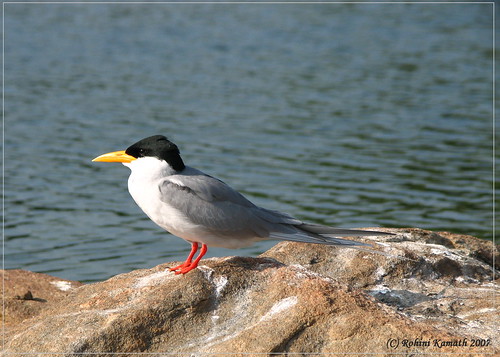
River Tern
River Sightings:
White Breasted Kingfisher
Pied Kingfisher
River Tern
Great Thick Knee (Great Stone Plover) – Pair
Black headed Ibis
Darters (Snake Birds)

Great Thick Knee
In the thickets along the walk way (particularly at the bridge), we saw several birds
Grey Headed Starling
Tickel’s Blue Fly catcher (again)
Drongos (Pair)
Paradise Fly catcher (juvenile male – rufus coloured, with little streamers)
Grey wagtail
Common Iora
Tailor Bird
Sunbirds
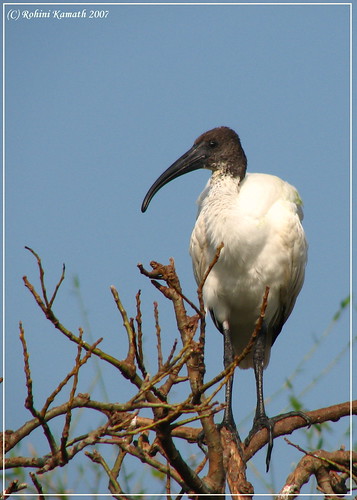 Black Headed Ibis |  Black Headed Munia  Snake Bird |
The lily pond near the restaurant yielded several sightings
Small Blue Kingfisher
Pied KingFisher (again)
Weaver Birds with nests
Spotted Munia
Black Headed Munia
White Rumped Munia ( several )
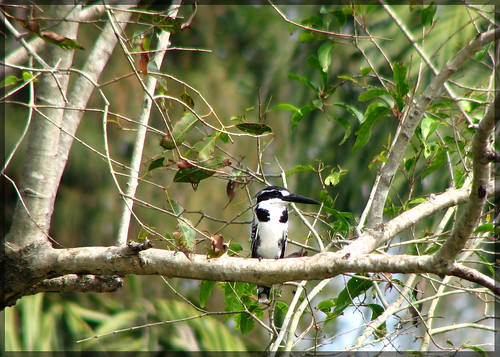
Pied KingFisher

White Rumped Munia Pair
Ranganthittu is sadly also visited by large groups of loud people who think it’s a great place for their unruly brats to work off their high spirits. It is most unfortunate that the park officials turn a blind eye to these pests.
Ranganathittu has a restaurant and clean rest rooms. It also has a large parking area. The park tends to get crowded once it opens ( offical opening hours are beyond 9 ). Park officials will admit visitors as early as 6:30 am for a fee - no ticket will be issued for this :) The boat men and guides are very well versed with local bird life.
Subscribe to:
Comments (Atom)

